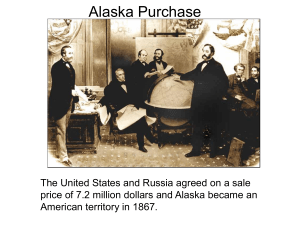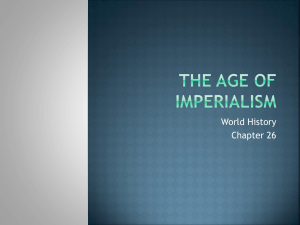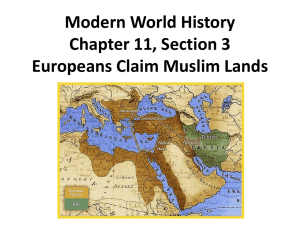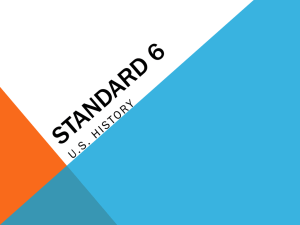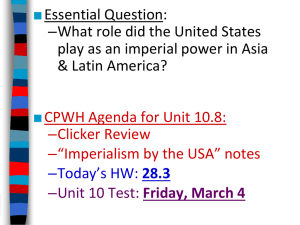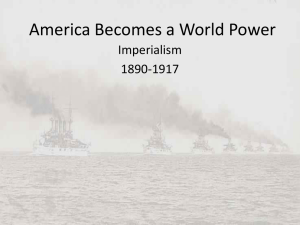CHAPTER 7 – NATIONALISM AND ECONOMIC GROWTH
advertisement
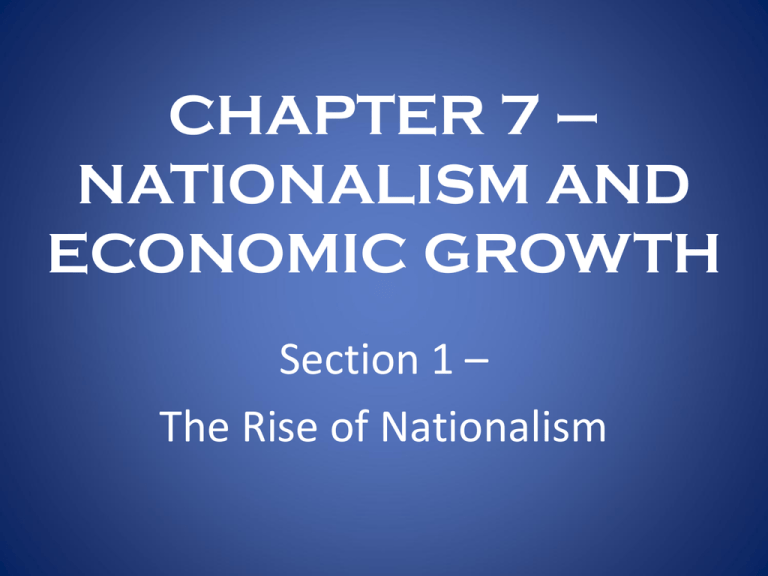
CHAPTER 7 – NATIONALISM AND ECONOMIC GROWTH Section 1 – The Rise of Nationalism A. Nationalism Takes Root 1. What is Nationalism? – National pride or loyalty, went up after War of 1812 2. Election of 1816 – a) Candidates – Secretary of State James Monroe (R) vs. N.Y. Senator Rufus King (F) b) Result – Monroe wins easily • Last time the Federalists have a presidential candidate 3. Era of Good Feelings – political harmony B. Relations with Spain 1. Battle over West Florida 2. First Seminole War a) Spain’s attention focused on South America and Mexico b) Seminoles raid towns across border into Georgia c) Andrew Jackson – began seizing Spanish forts in Florida and fighting against Seminoles 3. Spain Decides to Deal a) Adams’ ultimatum – Spain needed to control Seminoles or give up East Florida b) Adams-Onis Treaty – gave East and West Florida to U.S. C. Monroe Doctrine 1. Revolutions – FYI: Latin American colonies started to revolt against Spain around 1810. Revolutions were usually supported by U.S. citizens, many were inspired by American Revolution a) Simon Bolivar – Venezuelan who fought in several revolutions in Latin America C. Monroe Doctrine 2. A Warning a) Why was Monroe worried about European influence in Latin America? b) Monroe Doctrine (1823) • U.S. would not interfere with any existing European colonies in Latin America, but would consider any attempt to regain or start new colonies as “dangerous to our peace and safety” – Reaction c) How did the Monroe Doctrine represent a change in U.S. foreign policy? CHAPTER 7 – NATIONALISM AND ECONOMIC GROWTH Section 2 – The Challenges of Growth A. The Economy 1. Rebuilding After the War of 1812 a) Manufacturing – improved during war. Why? b) Next step – find a balance between industry and agriculture 2. Weakness in the System a) No National Bank – Government forced to deal with state banks b) Money Problem – not enough gold or silver, so no loans c) Transportation Problem – all trade over land d) Reaction – combined effort btw business and gov’t B. The American System 1. Henry Clay a) Lawyer and politician from Kentucky, became Speaker of the House in 1811 – Later known as “The Great Compromiser” 2. Features of the American System a) National Bank b) Protective tariff c) National transportation system 3. Quickly accepted by Congress B. The American System 4. Tariff of 1816 a) Protective measure – placed duty on most imported factory goods b) What is the purpose for a protective tariff? c) Reaction – supported by northern manufacturers and opposed by southern farmers • Why this reaction? Hint: It’s the same old story as with any tariff at this time B. The American System 5. Transportation a) National Road – connected Cumberland, MD to Wheeling, WV and later Vandalia, IL b) Erie Canal – 363-mile long canal linked Lake Erie to Hudson River, built by New York State c) Canals in NJ – Morris Canal and Delaware and Raritan Canal – see other handouts for more info – Should such projects be aided by federal government or private business? Is this similar or different to today? The Federal Government built the National Road (National Pike) from Cumberland, MD, to Vandalia, IL, and gave it to the States in the 1830s to operate as a turnpike. As shown on this map, Maryland built an extension from Cumberland to the port of Baltimore. C. Transportation Revolution 1. Bad roads – trails became mudpits in the wet 2. Canals and Steamboats a) Midwest Problems – flatboats useless upstream b) Canal Projects – Erie Canal reduced cost of moving goods between Buffalo and NYC by 90 percent, helped launch other canals c) Fulton’s Folly – steamboat invented by Robert Fulton with Clermont in 1807 • Capable of carrying heavy loads upstream, used on Mississippi River within 10 years C. Transportation Revolution 3. Locomotives – began in Europe and came to U.S. in 1830s a) Advantages – could go anywhere tracks could be laid b) Disadvantages – broke down often c) Result – Continued to improve and more than $200 million was spent in 1840s C. Transportation Revolution 4. The Market Revolution a) What was it? National markets were created because regions could import needed goods, only had to produce what was most profitable b) Biggest gains felt in Midwest, where small towns now able to link to larger cities CHAPTER 7 – NATIONALISM AND ECONOMIC GROWTH New Jersey Canals: The Morris Canal and the Delaware and Raritan Canal The Morris Canal • • • • • • General Information West end: Philipsburg on the Delaware River East end: Jersey City on the Hudson River Length of main canal: 102.15 miles # of inclined planes: 23 # of locks: 23 lift locks and 11 guard locks http://shubie.chebucto.org/inclinemovie.htm What are inclined planes? The boats that moved up or down a hill in “plane cars” on rails with the power supplied by water from the upper level of the canal – this water flowing through a “Scotch turbine” located deep underground. The Morris Canal General Information • What are locks? – They move boats up or down to another level of water. Water either enters or exits the lock so the boat can go on. • Time for a one way trip: 5 days • Power source: 2 mules • Total elevation change: 1,674 feet up and down (peak height of 914 feet) The Morris Canal Important Dates • December 31, 1824: Morris Canal and Banking Company chartered by the State of New Jersey • July 12, 1825: Construction starts near what is now Ledgewood • November 4, 1831: First trip from Newark to Phillipsburg • 1836: Jersey City extension completed - 11.75 miles • November 29, 1922: State of New Jersey takes control of the canal • Spring, 1924: Canal drained • George P. MacCulloch: Morristown businessman who conceived the idea of the canal Morris Canal • • • • • Other Information Cost: Original: $2,104,413 Enlargement: $1,700,000 Tonnage: 1845 - 58,259 tons 1866 - 899,220 tons (maximum year) Only prosperous period was 1860 – 1870 – Can you guess why? • Large Aqueducts: Little Falls Aqueduct across Passaic River – 80 foot span • Pompton River Aqueduct between Mountain View and Lincoln Park – 236 feet long, 9 stone piers Morris Canal • Why was the canal built? – To deliver coal from Pennsylvania’s Lehigh Valley to New Jersey and New York • What else did the canal accomplish? – It gave a big boost to industry in the area (especially iron), and allowed the area to grow faster – Farm products, manufactured goods, raw materials and construction materials were also moved • Why did the canal eventually fail? – Railroads became a more efficient way of transporting bulk goods in the second half of the 19th century http://njhistorypartnership.org//mktRev/morrisCanal/morrisCanalTour.htm Delaware & Raritan Canal • Main Canal: Bordentown on Delaware River to New Brunswick on Raritan River – 44 miles – 14 locks • Dimensions: 75 feet wide x 8 feet deep (after 1851) • Locks: 24 feet wide x 220 feet long (after 1853) • Very simple design compared to Morris Canal – less than half as long and only 115 feet in elevation change – no inclined planes • Used by mule-towed canal boats, sailboats, steam tugs towing barges, freight boats, millionaires’ yachts and naval vessels • Opened in 1834, peak year was 1866, closed in 1932 CHAPTER 7 – NATIONALISM AND ECONOMIC GROWTH Section 3 – The Rise of Jacksonian Democracy A. The Election of 1824 1. Four Candidates – – John Quincy Adams (Mass.), Henry Clay (Ky.), William Crawford (Ga.) and Andrew Jackson (Tenn.) 2. Field Narrows – – Crawford gets sick and is unable to campaign but beats Clay in Electoral College – Result – House must decide winner – Why? – Why were there so many candidates? A. The Election of 1824 3. “Corrupt Bargain” – Clay gives his support to Adams, when Adams wins Clay becomes Secretary of State, Jackson cries foul – Why did Clay give his support to Adams? 4. Adams’ term – Had good ideas but refused to compromise with Congress, remembered as a bad president B. The Election of 1828 1. Andrew Jackson – “Old Hickory”, focused on running for President 2. Democratic Party – name given later to supporters of Jackson, usually farmers, workers and frontier settlers; i.e. “the common man” B. The Election of 1828 3. Jacksonian Democracy a) Name given to expansion of political participation regardless of class • Examples: Voters chose electors directly instead of state legislatures, expansion of voting rights led to even more new voters b) Personality Clash – election was more about personalities than the issues (i.e. Was Jackson’s marriage illegal?) c) Jackson Wins – 178-83 in Electoral College, 56 percent of popular vote – White House party out of control CHAPTER 7 – NATIONALISM AND ECONOMIC GROWTH Section 4 – Jackson’s Policies Define an Era A. A Question of Land 1. Issue of American Indians – a) What to do? Government decided they needed to be moved beyond American borders, especially those in Southeast b) Why? American Indians supported British in War of 1812 c) Affected tribes – Cherokee (Georgia), Chickasaw, Choctaw (both Mississippi), Creek (Alabama) and Seminole (Florida) B. American Indian Policy 1. Indian Removal Act a) Provided for relocation for all Indian nations east of Mississippi River to Indian Territory (now Okla.) b) Why? To avoid conflict with white settlers (land) 2. Resistance in Court a) Cherokee argued that they were a foreign nation b) Worcester v. Georgia (1831) – the states had limited power over Cherokee; federal government needed to protect Indian rights c) Aftermath – Ruling was ignored, Cherokee forced to move west B. American Indian Policy 3. Trail of Tears (1838) – a) What was it? Name given to 800mile journey that federal troops forced Cherokee to make to Indian Territory b) About 4,000 of 18,000 Cherokee died on the trip C. Nullification Crisis 1. Tariff of Abominations – a) What was it? 1828 tariff that doubled rates for certain imports b) Why were many southerners upset? 2. Doctrine of Nullification – a) Written by John C. Calhoun in an anonymous essay b) Based on Kentucky and Virginia Resolutions by Jefferson and Madison – Do you remember from Chapter 6 what it said? C. Nullification Crisis 3. South Carolina Crisis – a) Henry Clay attempted to negotiate a compromise b) South Carolina nullified two tariffs, threatened secession if government attempted to collect c) Calhoun resigns as Vice President d) Jackson’s warning – Bloodshed dealt will be dealt with harshly e) Result – Calhoun urges South Carolina to accept a new compromise tariff in 1833 • Sectionalism becomes more of a problem D. Rise of the Whigs 1. Election of 1836 – a) Jackson’s VP and handpicked successor Martin van Buren becomes President b) Senate had to choose VP, only time in history 2. Whig name – taken from Whig Party that had opposed King in Britain, called Jackson “King Andrew” – Why “King Andrew”? D. Rise of the Whigs 1. Election of 1840 a) Nominees – war hero William Henry Harrison (W) vs. Van Buren (D) b) Economic crisis practically guaranteed Whig victory c) Reliance on slogans – • “Tippecanoe and Tyler too”, “Van, Van he’s a used up man” d) Result – Harrison wins easily but dies after one month, shortest term ever e) John Tyler becomes first VP to take over





